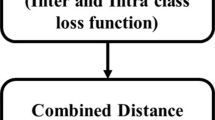Abstract
Linear regression technique is an efficient method to solve face recognition problem. It’s based on the theory that images in the same class will also belong to same linear subspace and they can be represented through a linear equation. However, this method suffers from some misclassification problems for the infinite ductility of regression equation, moreover, it also doesn’t make a proper and full use of the information in each sample. For overcoming these problems, a novel algorithm named the Distance Weighted Regression Classifier (DWLRC) is proposed here. It can be used for face recognition under different expression and illumination conditions through a distance weighted method, and it can also be used for optimizing the error in the final distance calculating stage. Experiments on three benchmarks show the better performance of our DWLRC compared with the traditional LRC and some state-of-art methods.









Similar content being viewed by others
References
Basri R, Jacobs DW (2003) Lambertian Reflectance and Linear Subspaces[J]. Pattern Anal Mach Intell IEEE Trans 25(2):218–233
Belhumeur PN, Hespanha JP, Kriegman DJ (1996) Eigenfaces vs. Fisherfaces: Recognition Using Class Specific Linear Projection[C]// European Conference on Computer Vision. Springer-Verlag, 45–58
Chai X, Shan S, Chen X et al (2007) Locally Linear Regression for Pose-Invariant Face Recognition[J]. IEEE Trans Image Processing 16(7):1716–1725
Chien JT, Wu CC (2002) Discriminant Waveletfaces and Nearest Feature Classifiers for Face Recognition[M]. IEEE Computer Society
Cover TM, Hart PE (1967) Nearest neighbor pattern classification[J]. IEEE Trans Inf Theory 13(1):21–27
Feng Q, Yuan C, Huang J, et al. (2015) Center-based weighted kernel linear regression for image classification[C]// IEEE International Conference on Image Processing. IEEE, 3630–3634
Feng Q, Zhu Q, Tang LL et al (2015) Double linear regression classification for face recognition[J]. J Mod Opt 62(4):288–295
Heisele B, Ho P, Poggio T (2001) Face Recognition with Support Vector Machines: Global versus Component-based Approach[C]// Computer Vision, 2001. ICCV 2001. Proceedings. Eighth IEEE International Conference on. IEEE, vol.2, 688–694
Ho J, Yang MH, Lim J et al. (2003) Clustering appearances of objects under varying illumination conditions[C]// Computer Vision and Pattern Recognition, 2003. Proceedings. 2003 IEEE Computer Society Conference on. IEEE, vol.1, :I-11-I-18
Jiang X, Mandal B, Kot A (2008) Eigenfeature Regularization and Extraction in Face Recognition[J]. IEEE Trans Pattern Anal Mach Intell 30(3):383–394
Leibe B, Schiele B (2003) Analyzing appearance and contour based methods for object categorization[C]// Computer Vision and Pattern Recognition, 2003. Proceedings. 2003 IEEE Computer Society Conference on. IEEE, vol.2, II-409-15
Lu J, Plataniotis KN, Venetsanopoulos AN et al (2006) Ensemble-based discriminant learning with boosting for face recognition[J]. IEEE Trans Neural Netw 17(1):166–178
Lu Y, Fang X, Xie B (2014) Kernel linear regression for face recognition[J]. Neural Comput Applic 24(7–8):1843–1849
Mi JX, Huang DS, Wang B et al (2013) The nearest-farthest subspace classification for face recognition[J]. Neurocomputing 113(7):241–250
Naseem I, Togneri R, Bennamoun M (2010) Linear Regression for Face Recognition[J]. IEEE Trans Pattern Anal Mach Intell 32(11):2106–2112
Nefian AV (2002) Embedded Bayesian networks for face recognition[C]// IEEE International Conference on Multimedia and Expo, 2002. ICME '02. Proceedings. IEEE, vol.2, 133–136
Samaria FS, Harter AC (1994) Parameterisation of a stochastic model for human face identification[C]// Applications of Computer Vision, 1994. Proceedings of the Second IEEE Workshop on. IEEE Xplore, 138–142
Semwal VB, Raj M, Nandi GC (2015) Biometric gait identification based on a multilayer perceptron[J]. Robot Auton Syst 65:65–75
Semwal VB, Mondal K, Nandi GC (2017) Robust and accurate feature selection for humanoid push recovery and classification: deep learning approach[J]. Neural Comput & Applic 28(3):565–574
Semwal VB, Singha J, Sharma PK et al (2017) An optimized feature selection technique based on incremental feature analysis for bio-metric gait data classification[J]. Multimed Tools Appl 76(22):24457–24475
Semwal VB, Gaud N, Nandi GC (2019) Human gait state prediction using cellular automata and classification using ELM[M]//Machine Intelligence and Signal Analysis. Springer, Singapore, pp 135–145
Wheeler FW, Liu X, Tu PH (2011) Handbook of Face Recognition (the second edition)[J]
Xu Y, Zhang D, Yang J et al (2011) A Two-Phase Test Sample Sparse Representation Method for Use With Face Recognition[J]. IEEE Trans Circuits Syst Video Technol 21(9):1255–1262
Yang J, Zhang D, Frangi AF et al (2004) Two-dimensional PCA: a new approach to appearance-based face representation and recognition[J]. IEEE Trans Pattern Anal Mach Intell 26(1):131
Zhu ML (2003) Face Recognition Using Kernel Methods[J]. Computer Science, 1457–1464
Acknowledgements
This work was supported by Shenzhen Science and Technology Plan under grant number JCYJ20180306171938767 and the Shenzhen Foundational Research Funding JCYJ20180507183527919.
Author information
Authors and Affiliations
Corresponding author
Additional information
Publisher’s note
Springer Nature remains neutral with regard to jurisdictional claims in published maps and institutional affiliations.
Rights and permissions
About this article
Cite this article
Tang, L., Lu, H., Pang, Z. et al. A distance weighted linear regression classifier based on optimized distance calculating approach for face recognition. Multimed Tools Appl 78, 32485–32501 (2019). https://doi.org/10.1007/s11042-019-07943-0
Received:
Revised:
Accepted:
Published:
Issue Date:
DOI: https://doi.org/10.1007/s11042-019-07943-0




